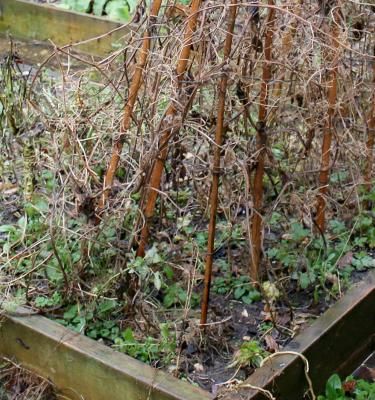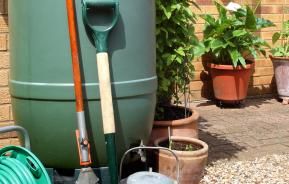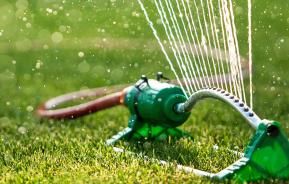After the wettest winter on record in 2020, flooding blighted tens of thousands of homes and gardens. But even more widespread is the waterlogging that has affected hundreds of thousands of gardens – particularly those on heavy, clay soils – and any garden with naturally wet soil.
Garden flooding and waterlogging rescue guide
The short-term effects of flooding and waterlogging may subside. But for plants and gardens, it is the severe longer-term problems that waterlogging can cause that gardeners need to be aware of – and do something about. And the longer the soil is saturated, the more severe the problems become.
The Miracle-Gro garden flooding and waterlogging rescue guide will help you overcome these problems and minimise the impact of the damage to ensure you can still enjoy your garden in the summer. Also included are some long-term solutions that may be worth looking into if wet weather, waterlogging and flooding are to become more commonplace.
Symptoms of flooding and waterlogging
Few garden plants, apart from willows and those such as bog plants that naturally grow in water, can survive prolonged periods of flooding or waterlogging. The water replaces the air in the soil and as roots need air to breathe, they literally drown, start to rot and die. Above ground, the leaves of affected plants show the first signs of the problem, turning yellow, wilting and dropping prematurely. Such symptoms are similar to those of drought because the dead roots are unable to take up water.
Other symptoms include:
- Shoots may start to die back and the whole plant may start to wilt – a sign that it is short of water since the damaged or dead roots can’t absorb any from the soil.
- Bark may start to peel off stems.
- Herbaceous plants may fail to come into growth in spring, or their leaves may open initially but then wilt and die.
- Bulbs start to rot and die.
- Plants may look stunted with poor, thin growth and, in the worst circumstances, completely die.
The good news is there are several things you can do to help rescue your plants and gardens - both in the short term and more permanently. Once the water has dissipated, plants will hopefully start to revive. Helping to build up the strength of your plants once the water goes down is the best way of rescuing them from these serious problems.
Short-term plant rescue
- Don’t walk on waterlogged soil - especially heavy clay soils - until it has dried out and is workable, to avoid compacting it and making soil and growing conditions for plants worse. If you have to walk on it, use a plank of wood, board or invest in a portable path to spread your weight and so help avoid this compaction.
- Miracle-Gro Moisture Control Decorative Pine Bark, Levington Decorative Chipped Forest Bark or Levington Water Saving Decorative Bark can be used on paths and soil to make it easier to walk on and to soak up excessive moisture.
- As soon as plants start to come into growth, apply foliar feeds of Miracle-Gro All Purpose Soluble Plant Food. This will help encourage new root growth to replace those killed by the wet conditions, as well as help improve leaf and stem growth.
- Feed flowering plants with Miracle-Gro All Purpose Continuous Release Plant Food. We also supply a continuous release feed for roses and shrubs and for ericaceous plants - see products listed right. These controlled-release ‘smart’ feeds will gradually release nutrients into the soil for up to 6 months to help build up the strength of the plants and aid recovery. Being controlled release, they will not damage or burn the sensitive plant roots.
- Feeding with Miracle-Gro Bone Meal Natural Root Builder will help plants produce a new root system.
- You may need to prune out badly damaged or dead shoots but wait until May at the earliest, or even June, as it can take plants this long to show signs of recovery.
- This may sound bizarre, but you may have to water plants thoroughly during dry spells following waterlogging, as they will be more susceptible to drought stress due to their reduced and damaged root system.
Lawn rescue
Grass in the lawn is equally susceptible to flooding and waterlogging as any other plant in the garden.
- As with your beds and borders, keep off the lawn until it has dried out. Treading on saturated soil will cause compaction, reducing the lawn’s aeration and drainage even further and make the problem worse – both now and in the long term.
- Then thoroughly spike the lawn all over either using a garden fork or, better still, a hollow-tine aerator. Brushing sharp sand into the holes will further improve the drainage.
- Feed-in both spring and summer with Miracle-Gro EverGreen Complete 4-in-1, which will help green up the lawn and help the grass recover from the adverse weather.
- Where areas of grass have died out, reseed them with Miracle-Gro Patch Magic. This contains a combination of grass seed, 4-month feed and coir compost. It ensures excellent results anywhere – from high traffic areas to harsh sun and dense shade. It’s the only patching mix that takes care of the seed so anyone can grow thick, beautiful grass. Miracle-Gro Patch Magic grass builds stronger roots and leaf growth that survive virtually every tough condition.
Grow your own rescue
- In flooded gardens and allotments, edible crops in the ground are probably best discarded and not eaten, as various pollutants and even raw sewage may have affected them. As these pollutants can remain in the soil for a relatively long time, you may have to forego growing any crops in the ground this year.
- In gardens and allotments that have been waterlogged, adding lots of bulky organic matter to the soil, as detailed below in Long-term prevention, will improve the soil structure and allow you to sow and grow vegetables this year.
- But don’t forget that just about every vegetable can be grown in containers, so if your soil isn’t suitable for crops this year, grow them in pots. Find out more about growing your own in containers.
Long-term prevention
- Light, sandy soils are generally well-drained and, once the water level has gone down, usually recover quite quickly. Heavy clay soils, on the other hand, often retain the water for much longer and can take a long time to recover.
- The waterlogging and torrential rainfall will have leached plant nutrients out of the soil, so make sure you feed plants thoroughly throughout the year.
- Affected soils need to be worked on to help improve the rooting conditions and drainage.
- Start by digging over the soil, ideally to a depth of 38-45cm (15-18in), breaking up any hard or compacted clay soil layers or ‘pans’ (you may need a pickaxe or similar for this). Then improve the soil by digging in lots of bulky organic matter, such as home-made compost, Levington Organic Blend Soil Conditioner or Levington Organic Blend Farmyard Manure at the rate of a wheelbarrowful to every 2-3 sq m/sq yd. On very heavy soils, add a 2.5cm (1in) thick layer of sharp sand or grit on the soil before digging and work this in at the same time.
- Miracle-Gro Lime Natural Soil Improver helps break down heavy clay soil, improving drainage, structure and quality.
- If this doesn’t cure the problem, dig a sump at the lowest point in the garden. This should be about 60-90cm (2-3ft) square and as deep as need be to ensure the water drains away. Then fill it with brick rubble, stones etc. Top off with gravel. You can then lay a planting membrane on top and cover over with soil if you need to plant there - but this is often best avoided, as the soil will drain very quickly.
If this doesn’t work, then you should seek the advice of a professional to help you lay land drains.








